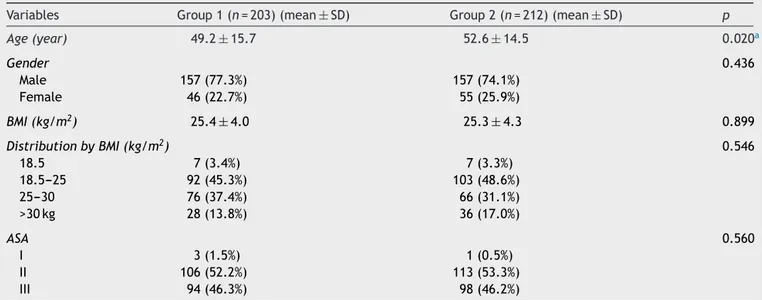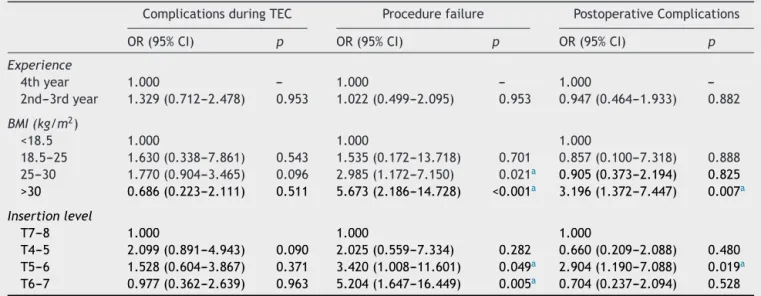REVISTA
BRASILEIRA
DE
ANESTESIOLOGIA
OfficialPublicationoftheBrazilianSocietyofAnesthesiologywww.sba.com.br
SCIENTIFIC
ARTICLE
Teaching
practices
of
thoracic
epidural
catheterizations
in
different
grade
of
anesthesia
residents
夽
Ali
Alagoz
a,∗,
Hilal
Sazak
a,
Mehtap
Tunc
a,
Fatma
Ulus
a,
Serdar
Kokulu
b,
Polat
Pehlivanoglu
a,
Saziye
Sahin
caDepartmentofAnesthesiologyandReanimation,AtaturkChestDiseaseandThoracicSurgeryTrainingandResearchHospital,
Ankara,Turkey
bDepartmentofAnesthesiologyandReanimation,FacultyofMedicine,AfyonKocatepeUniversity,Afyonkarahisar,Turkey
cDepartmentofAnesthesiology,FacultyofDentistry,GaziUniversity,Ankara,Turkey
Received3July2014;accepted28July2014 Availableonline27October2014
KEYWORDS Residencytraining; Thoracicepidural catheterization; Failurerate; Complications
Abstract
Backgroundandobjectives: In this study,we aimed to clarify the importance ofresidency grade andotherfactorswhich influence thesuccessofthoracicepidural catheterization in thoracotomypatients.
Methods:Aftertheethicalcommitteeapproval,datawererecordedretrospectivelyfromthe chartsof415patients.Allpatientshadgivenwritteninformedconsent.Thethoracic epidu-ralcatheterizationattemptsweredividedintotwogroupsassecond---thirdyear(GroupI)and fourthyear(GroupII)accordingtoresidencygrade.Weretrospectivelycollecteddemographic data, characteristics ofthoracic epidural catheterization attempts, and all difficulties and complicationsduringthoracicepiduralcatheterization.
Results:Overall success rate ofthoracic epidural catheterization was similar between the groups.Levelsofcatheterplacement,numberanddurationofthoracicepiduralcatheterization attempts werenotdifferentbetweenthegroups(p>0.05).Changeofneedleinsertionlevel was statistically higherin Group II (p=0.008),whereas paresthesia was significantly higher inGroupI(p=0.007).Duralpunctureandpostdural punctureheadacherateswerehigherin Group I. Higherbody massindexandleveloftheinsertion sitewere significantfactorsfor thoracicepiduralcatheterizationfailureandpostoperativecomplicationrateandthosewere independencefromresidents’experience(p<0.001,0.005).
夽 ThisstudywaspresentedasaposterWorldInstituteofPain6thWorldCongressofWorldInstituteofPain.February4---6,2012,Miami
Beach,Florida,US.
∗Correspondingauthor.
E-mail:mdalagoz@gmail.com(A.Alagoz).
http://dx.doi.org/10.1016/j.bjane.2014.07.010
Conclusion:Bodymassindexandlevelofinsertionsiteweresignificantonthoracicepidural catheterizationfailureandpostoperativecomplicationrate.Wethinkthatresidents’gradeis notasignificantfactorintermsoverallsuccessrateofthoracicepiduralcatheterization,but itisimportantforoutcomeoftheseprocedures.
©2014SociedadeBrasileiradeAnestesiologia.PublishedbyElsevier EditoraLtda.Allrights reserved.
PALAVRAS-CHAVE Treinamentoem residência;
Cateterismoepidural torácico;
Taxadefalha; Complicac¸ões
Ensinodapráticadecateterismoepiduraltorácicoemdiferentesanosderesidência emanestesia
Resumo
Justificativaeobjetivos: Neste estudo o objetivo foi esclarecer a importância do ano de residênciaeoutrosfatoresqueinfluenciamosucessodocateterismoepiduraltorácico(CET) empacientessubmetidosàtoracotomia.
Métodos: Apósaaprovac¸ãodoComitêdeÉtica,osdadosforamretrospectivamenteanalisados apartirdosprontuáriosde415pacientes.Todosospacientesassinaramostermosde consen-timentoinformado.AstentativasdeCETforamdivididasemdoisgrupos:segundo-terceiroano (GrupoI)equartoano(GrupoII),deacordocomoanoderesidência.Dadosdemográficos, car-acterísticasdastentativasdeCETetodasasdificuldadesecomplicac¸õesduranteoCETforam registradosretrospectivamente.
Resultados: A taxade sucesso global de CETfoi semelhante entre osgrupos. Os níveis de colocac¸ãodocateter,onúmeroeadurac¸ãodastentativasnãoforamdiferentesentreosgrupos (p>0,05).A alterac¸ãodoníveldeinserc¸ãodaagulhafoiestatisticamentemaiornoGrupoII (p=0,008),enquantoqueaparestesiafoisignificativamentemaiornoGrupoI(p=0,007).As taxasdecefaléiaduranteeapóspunc¸ãoduralforammaioresnoGrupoI.Umíndicedemassa corporal(IMC)maioreoníveldolocaldeinserc¸ãoforamfatoressignificativosparaofracasso doCETeparaastaxasdecomplicac¸õesnopós-operatório,masindependentesdaexperiência dosresidentes(p<0,001,0,005).
Conclusão:OIMCeoníveldolocaldeinserc¸ãoforamsignificativosparaofracassodoCETe paraastaxasdecomplicac¸õesnopós-operatório.Pensamosqueoanoderesidêncianãoéum fatorsignificativoemtermosdetaxadesucessoglobalparaoCET,maséimportanteparao resultadodessesprocedimentos.
©2014SociedadeBrasileiradeAnestesiologia.PublicadoporElsevierEditoraLtda.Todosos direitosreservados.
Introduction
Asamethodofchoiceforanalgesicmanagementofthoracic and upperabdominal surgery, thoracic epidural catheter-ization (TEC) is one of the most difficult procedures in anesthesiapractice.1 Although TEC is a gold standard for
thoracotomypain,itisrelatedtospecificcomplicationsand contraindicationswhichmaylimitits’usage.1---4 The
estab-lishmentofbalancebetweenanesthesiaresidencytraining and safety of patients is ongoing dilemma in anesthesia interventions,especiallyinTEC.5,6TheTECmayalsobecome
complicated due to anatomical difficulty and variations. Residencygradeand previous experiencemight be impor-tantfactorsinachievingsuccessfulTECattempt, whereas noexactcriteriahave been mentioned asregardsto tim-ingforinitiationof TECtraining.7---9In general,anesthesia
residents have sufficient experience on spinal anesthesia andlumbarepiduralcatheterizationbeforetheTEC train-ing, but learning curve of TEC attempts is uncertain.8---11
WhetherresidentseducatedlumbarepiduralbeforeTECor notwasnotanimportantfactorforexperience.12TECisalso
secureandeasytoteachwithaverylowincidenceofserious complications.12 Tothebestofourknowledge,thearticles
evaluating regionalanesthesiatraining of anesthesia resi-dents,inparticularfocusingonTEC,havebeenlimited.In thisstudy,weaimedtoclarifytheimportanceofresidency gradeandotherfactorswhichinfluencethesuccessofTEC inthoracotomypatients.
Methods
Table1 Demographicdata andAmericanSociety ofAnesthesiology (ASA)physicalstatusofpatients intermsofresidency grade.
Variables Group1(n=203)(mean±SD) Group2(n=212)(mean±SD) p
Age(year) 49.2±15.7 52.6±14.5 0.020a
Gender 0.436
Male 157(77.3%) 157(74.1%)
Female 46(22.7%) 55(25.9%)
BMI(kg/m2) 25.4±4.0 25.3±4.3 0.899
DistributionbyBMI(kg/m2) 0.546
18.5 7(3.4%) 7(3.3%)
18.5---25 92(45.3%) 103(48.6%)
25---30 76(37.4%) 66(31.1%)
>30kg 28(13.8%) 36(17.0%)
ASA 0.560
I 3(1.5%) 1(0.5%)
II 106(52.2%) 113(53.3%)
III 94(46.3%) 98(46.2%)
GroupI,2nd---3rdyearresidents;GroupII,4thyearresidents;BMI,bodymassindex;ASA,AmericanSocietyofAnesthesiology.Demographic
datawerepresentedasmean±SDanddistributionofBMI,gender,andASAwerepresentedasnumericalvaluesandpercentage.
a p<0.05,comparisonbetweengroups.
weredividedintotwogroupsassecond---thirdyear(GroupI) andfourthyearresidencygrade(GroupII).
All interventions, including TEC, which performed by theresidentshavebeen achievedunderthesupervisionof staff anesthesiologists.The failed process wasdefined as 3sequentialunsuccessfulattemptsorinterventionslasting morethan15min,Touhyneedlerelatedduralpuncture,and persistentbleedingfromcatheterorneedle.IncaseofTEC failure,thestaff anesthesiologistperformed thoracic par-avertebralblock at the endof surgery, and postoperative analgesia was provided with multimodal analgesia tech-niques.
We retrospectivelycollecteddemographicdata, Ameri-canSocietyofAnesthesiology(ASA)physicalstatus,thelevel andanychangeoftheinsertionlevel,durationandnumber
of TEC attempts, and all difficulties during TEC. We also reviewedpaincharts for thesatisfaction ofpain manage-ment,TECrelatedpostoperativecomplicationswhichwere includedkinking,obstructionanddislodgementofthe tho-racic epidural catheter, hypotension, post dural puncture headache(PDPH),hyperemiaatthecatheterinsertionsite, andipsilateralshoulderpain.
Statistical analysis was performed using SPSS 11.5 for Windows. Descriptive statistic was expressed as mean±standard deviation,andcategoricalvariableswere expressed as case number and percentage. Student-t
test was performed to compare mean values in groups. Pearson’s chi-square, Fisher’s exact test, chi-square or likelihoodratiowereperformedtoevaluatethecategorical variables. The effect of residents’ experience, patients’
Table2 Characteristicsofthoracicepiduralcatheterization(TEC).
Variables GroupI(n=203) GroupII(n=212) p
Touhyneedleinsertionlevel 0.257
Thoracic4---5 55(27.1%) 53(25.0%)
Thoracic5---6 50(24.6%) 42(19.8%)
Thoracic6---7 42(20.7%) 61(28.8%)
Thoracic7---8 56(27.6%) 56(26.4%)
Numberofattempts 0.320
1 93(45.8%) 91(42.9%)
2 48(23.6%) 42(19.8%)
3 62(30.5%) 79(37.3%)
aDurationofTECattempts(min) 0.715
0---5 101(49.8%) 99(46.7%)
5---10 66(32.5%) 77(36.3%)
10---15 36(17.7%) 36(17.0%)
GroupI,2nd---3rdyearresidents;GroupII,4thyearresidents.
Table3 Patients’satisfactionanddifficultiesrelatedtothoracicepiduralcatheterization.
Variables GroupI(n=203) GroupII(n=212) p
Numberofinsertionlevelchange 46(23.0%) 72(35.0%) 0.008a
Bleedingb 16(8.0%) 15(7.3%) 0.785
Duralpuncture 3(1.5%) 1(0.5%) 0.366
Difficultyofcatheteradvance 4(2.0%) 7(3.4%) 0.386
Paresthesia 7(3.5%) --- 0.007a
ComplicationsduringTEC 25(12.5%) 20(9.7%) 0.370
TECfailurerate 18(8.9%) 19(9.0%) 0.973
Patients’satisfaction 0.857
Excellent 103(50.7%) 102(48.1%)
Good 61(30.0%) 66(31.1%)
Moderate 36(17.8%) 42(19.8%)
Bad 3(0.15%) 2(0.1%)
TEC,thoracicepiduralcatheterization;Datawerepresentedaspatients’numberandpercentage.GroupI,2nd---3rdyearresidents;
GroupII,4thyearresidents.
ap<0.05,comparisonbetweengroups.
b BleedingthroughepiduralcatheterorTouhyneedle.
age, body mass index (BMI), and level of insertion site on complication during TEC, procedure failure, and TEC relatedpostoperativecomplicationswereanalyzedbyusing Univariate Logistic Regression analyses. The effect of all probableriskfactorsoncomplicationduringTEC,procedure failure,andTECrelatedpostoperativecomplicationswere analyzed byMultivariate Logistic Regression analysis.Odd ratio(OR)and95%confidenceinterval(CI)werecalculated foreachvariables.Statisticallysignificantdifferenceswere acceptedasp<0.05.
Results
Average age of patients was slightly higher in Group II (p<0.020). There was no significant difference in
terms of gender, BMI, and ASA physical status (p>0.05) (Table1).
Differences in the Touhy needle insertion level, num-ber and duration of TEC attempts were not significant betweenthegroups(p>0.05)(Table2).Thenumberof nee-dleinsertionlevelchangewasstatisticallyhigherinGroupII (p=0.008).Paresthesiafrequencywassignificantlyhigherin GroupI(p=0.007).Therewerenostatisticallydifferencein termsofbleedingthroughepiduralcatheter,difficultyofthe catheteradvance,andfailurerate(p>0.05).Patients’ sat-isfactionswerenotdifferentbetweenthegroups(p>0.05) (Table3).Distribution ofpostoperativecomplications rate wasnotstatisticallydifferentbetweenthegroups(p>0.05). TheBMIand levelof theinsertionsiteweresignificant factorsonTECfailureandpostoperativecomplicationrate, and there were independent from residents’ experience. Postoperative complicationrate was3.196times higherin
Table4 Thecorrelation betweenresidency grade,body massindex(BMI),andthe levelofneedleinsertionandthoracic epiduralcatheterization(TEC)relatedcomplicationsandprocedurefailurerate.
ComplicationsduringTEC Procedurefailure PostoperativeComplications
OR(95%CI) p OR(95%CI) p OR(95%CI) p
Experience
4thyear 1.000 --- 1.000 --- 1.000
---2nd---3rdyear 1.329(0.712---2.478) 0.953 1.022(0.499---2.095) 0.953 0.947(0.464---1.933) 0.882
BMI(kg/m2)
<18.5 1.000 1.000 1.000
18.5---25 1.630(0.338---7.861) 0.543 1.535(0.172---13.718) 0.701 0.857(0.100---7.318) 0.888 25---30 1.770(0.904---3.465) 0.096 2.985(1.172---7.150) 0.021a 0.905(0.373---2.194) 0.825
>30 0.686(0.223---2.111) 0.511 5.673(2.186---14.728) <0.001a 3.196(1.372---7.447) 0.007a
Insertionlevel
T7---8 1.000 1.000 1.000
T4---5 2.099(0.891---4.943) 0.090 2.025(0.559---7.334) 0.282 0.660(0.209---2.088) 0.480 T5---6 1.528(0.604---3.867) 0.371 3.420(1.008---11.601) 0.049a 2.904(1.190---7.088) 0.019a
T6---7 0.977(0.362---2.639) 0.963 5.204(1.647---16.449) 0.005a 0.704(0.237---2.094) 0.528
OR,oddsratio;CI,confidenceinterval;TEC,thoracicepiduralcatheterization;BMI,bodymassindex.
obesepatientsaccordingtonormalweightpatients(95%CI: 1.372---7.447;p=0.007).
PostoperativecomplicationratewasalsohigherinT5---6 groupwhencomparedtheT7---8group(OR,2.904;95%CI: 1.190---7.088;p=0.019)(Table4).TheTECfailureratewas significantly higherin overweight patient(OR, 2.985;95% CI:1.172---7.150),(p=0.021)andobesepatients(OR,5.673; 95%CI: 2.186---14.728),(p<0.001) whencomparedto nor-malweightpatients.FailureratewasalsoincreasedinT5---6 level(OR,3.420;95%CI:1.008---11.601;p=0.049)andT6---7 (OR,5.204;95%CI:1.647---16.449; p=0.005),accordingto T7---8 level (Table 4). There was no correlation between complicationduringTECandresidentsexperience,patients’ age,BMI,andlevelofinsertionsite(p>0.05)(Table4).
Conclusion
Inpresentstudy,retrospectiveanalysisof415TECattempts showed that BMI and level of insertion site were con-siderable factors for procedure failure and postoperative complicationrate.Althoughabsenceofseriousneurological complications, paresthesia wasmore frequent in 2nd---3rd residents.DuralpunctureandPDPHrateswerealsohigher inthisgroup.
Various reports have been published to determine the sufficientepiduralcatheterattemptsforresidencytraining, butnumberofattemptstoachieveadequateexperienceis still unclear.5,8,9,12 According to the Accreditation Council
forGraduateMedicalEducation,residentsshouldperform50 epiduralcatheterizationsduringtraininginanesthesiology.13
On the other hand, at least 20---25 epidural blocks are necessary to achieve consistency in residency training in anesthesiology.9Recommendedminimumnumberoflumbar
epiduralcatheterizationpriortoTECtraininginliteratures islimited.Inourdepartmentallresidentsperformatleast 20lumbarepiduralcatheterinsertionsbeforetheTEC train-ing. All attempts are performed under the supervision of staffanesthesiologist.
Midlineor paramediantechniques maybepreferredfor TEC.Approximatelyfiftypercentofanesthesiologyprograms teachesbothmidlineandparamedianapproachesinUnited States.12 Midline approach had a higher success rate and
required fewerattempts thanthe paramedian approach.9
Inanotherstudy,researchersdidnotfoundanydifferences in success ofthe firstattempt or numberof attempts for eithertypeof block,regardlessofthe approach.14
Advan-tagesordisadvantagesofmidlineorparamedianapproach during TEC have been mentioned by the authors.12,15 We
preferredmidlineapproachandourresidentswere comfort-ablewhileusingthisapproachandhanging-droptechnique forTEC.Lossofresistantandhanging droptechniquesare usedtodetectepiduralspace.Hangingdroptechniquewas safe andcomfortable onsitting positiondue tohigh neg-ative pressure at thoracic level.16 We also performed all
catheterizations in sitting position by using hanging-drop technique.
No exact criteria have been mentioned in the articles intermsofdurationandnumberofTECattempttodefine theprocedurefailure.Twounsuccessfulattemptsorsingle attemptrequiredmorethan10minwasdeterminedas pro-cedure failurein alarge numberlumbar andlow-thoracic
epiduralcatheterization study.17 In the present study, we
definedthefailureas3unsuccessfulattemptsorthe proce-durelastingformorethan15min.Ourcriteriaforprocedure failureweremoreflexiblethanthisstudyduetotechnical difficultiesofmid-thoracicTEC.17
TheBMIisoneofthemostimportantfactorsfor epidu-ralcatheterization.Correctidentificationoftheanatomical landmarksinTEC is thefirststep forsuccessful catheter-ization without severe complications. Main challenges in performing regional anesthesia in obese patients are the appropriate landmark identification, the correct patient positioning,and the useof appropriate equipment.18 The
lack ofthese issuesmay increase thefailure ratein neu-roaxialblockade.Ourstudyindicatedthatthesuccessrate of TEC was converselycorrelated in overweight or obese individuals,anditwasindependentfromresidencygrade. We thinkthat subcutaneous fat tissuemight affect nega-tivelytheidentificationoflandmarkinobeseandoverweight patients.
Mid-thoracicepidural catheterinsertionis adequate to provideanesthesiaandpostoperativeanalgesiaforthoracic surgery.14 Extreme upward angulations’ofthe Touhy
nee-dlemakes insertion more difficult particularly in the mid andhigh thoracicregions.18 To thebestof ourknowledge
norecommendation about success rate of TEC related to level of insertion site in mid-thoracic region in articles. Weperformed allTEC placements at mid thoracic levels, andwefound significant differenceswithrespecttolevel ofinsertionsite.ComparedtoT7---8level,failureratewas morefrequentinuppermid-thoracicregions.Itcouldreflect thedifficulty of procedure at higher mid-thoracic region. Advancedresearchesmaybehelpfultoidentifytheoptimal levelforinsertionincludedthisarea.
The TEC related complications is in a wide range, but neurological injuries are the most crucial complica-tionin anesthesia practice.Due topotential neurological sequel,the risk-benefit ratio of thoracic epidural analge-sia is controversial.3 Our results showed that the rate of
neurologicalcomplicationswasquite low.Paresthesia was observed only 7 patients included in 2nd---3rd year resi-dents group. Dural puncture and PDPH were also higher in this group. Even if success rate of TEC is similar in groups, the high frequency of paresthesia and PDHD couldexplaintheimportanceofexperienceandresidency grade.
Untilnow,theassociationsbetweenthenumberofTEC attempts and operator experience have been studied by the investigators, but no definitive information was pro-vided.Inonestudy,first-yearresidentssuccessfullylocated the epidural space in 76% of cases.9 An another study
either did not find a significant association between the level of training and first-level success.14 We found that
thenumber of TEC attempts washigher in 4thyear resi-dentsgroup.Consideringsafetyandtraumaduringepidural attemptsmightbehelpfultoeliminatethecomplications. Less traumatic procedure may be related to operator’s experience.19 We think that the number of attempts
In conclusion, TEA is one of the major components ofthoracicand thoraco-abdominalanesthesiaand postop-erative pain management. In our study, BMI and level of insertionsiteweresignificant factorsonprocedure failure and postoperative complication rate. These factors were independentfromresidents’grade.Previouslumbar epidu-ral and spinal block experience couldbe helpful for high success rate on TEC. The incidence of technical difficul-ties, procedure-related complications, and postoperative complications were quite low during TEC. Although suc-cess rate of TEC was similarin both groups, TEC related complications rate was higher in 2nd---3rd year group. It shouldberelatedtoexperienceandresidents’grade.
Conflicts
of
interest
Theauthorsdeclarenoconflictsofinterest.
References
1.Giebler RM, Scherer RU, Peters J. Incidence of neurologic complications related to thoracic epidural catheterization. Anesthesiology.1997;86:55---63.
2.WheatleRG,SchugSA,WatsonD.Safetyandefficacyof post-operativeepiduralanalgesia.BrJAnaesth.2001;87:47---61.
3.FreiseH,VanAkenHK.Risksandbenefitsofthoracicepidural anaesthesia.BrJAnaesth.2011;107:859---68.
4.Pöpping DM,ZahnPK,VanAkenHK,etal. Effectivenessand safetyofpostoperativepainmanagement:a surveyof18925 consecutivepatientsbetween1998and2006(2ndrevision):a databaseanalysisofprospectivelyraised data.Br JAnaesth. 2008;101:832---40.
5.KonradC,SchüpferG, WietlisbachM,etal.Learningmanual skills in anesthesiology: is there a recommended numberof casesforanestheticprocedures?AnesthAnalg.1998;86:635---9.
6.DeOliveiraFilhoGR.Theconstructionoflearningcurves for basic skills in anesthetic procedures: an application for the cumulativesummethod.AnesthAnalg.2002;95:411---6.
7.Smith MP, Sprung J, Zura A, et al. A survey of exposure to regionalanesthesiainAmericananesthesia residencytraining programs.RegAnesthPainMed.1999;24:11---6.
8.KopaczDJ, NealJM.Regional anesthesia andpain medicine: residency training --- the year 2000. Reg Anesth Pain Med. 2002;27:9---14.
9.Kopacz DJ, Neal JM, Pollock JE. The regional anesthesia ‘‘learningcurve’’:whatistheminimumnumberofepiduraland spinalblockstoreachconsistency?RegAnesth.1996;21:182---90.
10.AmericanMedical,Association.Programrequirementsfor res-idency education in anesthesiology. In: Graduate medical educationdirectory1996. Chicago:American Medical Associ-ation;1996.p.34---7.
11.Aitkenhead AR. Undergraduate and postgraduate education. BestPractResClinAnaesthesiol.2002;16:375---90.
12.SaiedNN,HelwaniM,TabakianH,etal.Teachingpracticesof thoracicepiduralanesthesiaintheUnitedStates:shouldlumbar epiduralsbetaughtbeforethoracicepidurals?JCardiothorac VascAnesth.2006;20:652---5.
13.Program requirements for graduate medical education in
anesthesiology.TheAccreditationCouncilforGraduateMedical
EducationEffectiveinJuly1st,2003.Availableat:http://www.
acgme.org/acWebsite/downloads/RRCprogReq/040pr703 u804.pdf[accessed25.10.05].
14.SprungJ,BourkeDL,GrassJ,etal.Predictingthedifficult neu-raxialblock:aprospectivestudy.AnesthAnalg.1999;89:384---9.
15.McLeod GA, Cumming C.Thoracic epidural anaesthesia and analgesia.ContinuingEducationinAnaesthesia.CritCarePain. 2004;4:16---9.
16.GilNS,LeeJH,YoonSZ,etal.Comparisonofthoracicepidural pressureinthesittingandlateraldecubituspositions. Anesthe-siology.2008;109:67---71.
17.Dalsasso M, Grandis M, Innocente E, et al. A survey of 1000 consecutive epidural catheter placements performed by inexperienced anesthesia trainees. Minerva Anestesiol. 2009;75:13---9.
18.IngrandeJ,BrodskyJB,LemmensHJ.Regionalanesthesiaand obesity.CurrOpinAnaesthesiol.2009;22:683---6.

